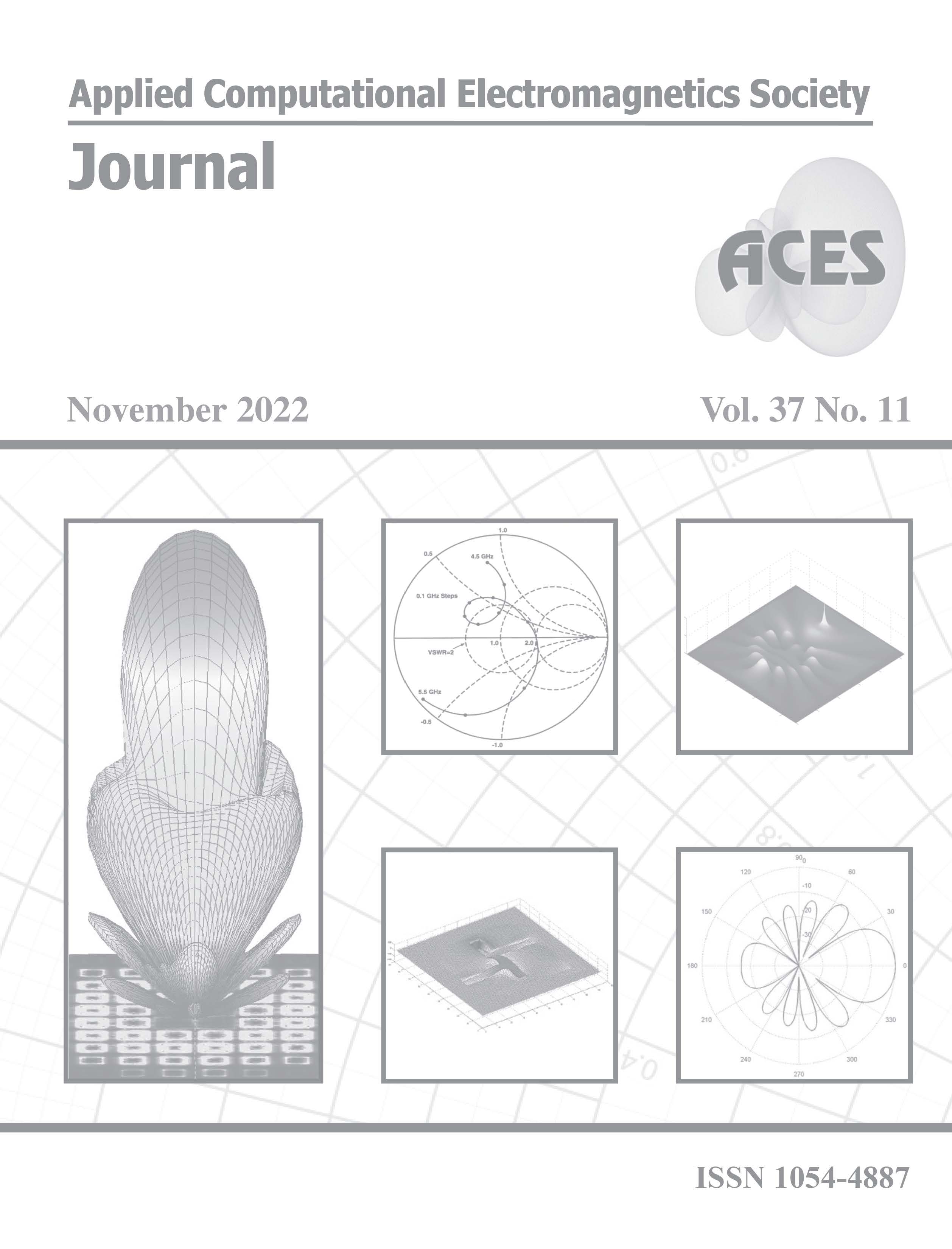Single-band Series Absorptive Common-mode Noise Filter
DOI:
https://doi.org/10.13052/2022.ACES.J.371104Keywords:
Absorptive common-mode filter (ACMF), absorption efficiency (AE), common-mode filter (CMF)Abstract
A Single-band Series Absorptive Common Mode Noise Filter (ACMF) is proposed. The ACMF is embedded in a four-layer printed circuit board (PCB) and consists of three parts: a Reflective Common Mode Noise Filter (RCMF), a matching circuit, and an absorber. The RCMF is designed using mushroom-type resonators. The matching circuit is designed using meander lines to reduce the size of the filter dimensions. The absorber of the Common Mode noise (CM) is a series resistor. The designed operating frequency is 2.45 GHz. The simulation results are as follows: the insertion loss of CM (Scc21) is -22.49 dB at the frequency of 2.61 GHz, the return loss of CM (Scc21) is -18.62 dB at the frequency of 2.5 GHz, while the integrity of the Differential Mode signals (DM) can be maintained with a very small insertion loss (Sdd21) of -1 dB at the frequency range of 0-8 GHz, and the achieved Absorption Efficiency (AE) is 93% at the frequency of 2.54 GHz. The proposed ACMF dimension is 10.3 x4.6 mm. The fractional bandwidth is 19%. The measurement results of the fabricated ACMF do not deviate significantly the simulation results. They are as follows: Scc21 is -17.87 dB at the frequency of 2.31 GHz, Scc11 is -20.87 dB at the frequency of 2.38 GHz, Sdd21 is -2.8 dB at the frequency range of 0–8 GHz, the Absorption Efficiency is 97% at the frequency of 2.32 GHz, and the fractional bandwidth is 17%. Therefore, the results of the ACMF design carried out by simulation can be implemented into a fabricated ACMF with measurement results similar to the calculation results in the design.
Downloads
References
C. Y. Zhuang, T. Adiprabowo, D. B. Lin, Y. H. Chen, Y. H. Zheng, B. H. Tsai, and A. A. Pramudita, “A broadband common-mode filter by using dual band transmission zero,” 2021 Asia-Pacific International Symposium on Electromagnetic Compatibility (APEMC), pp. 1-3, 2021.
Z. Zhu, W. Yan, Y. Wang, Y. Zhao, T. Zhang, and J. Huang, “Noise analysis method of radiated EMI based on non-linear principal component analysis,” Applied Computational Electromagnetics Society (ACES) Journal, vol. 35, no. 10, p. 1144–1152, 2020.
Z. Chen and G. Katopis, “A comparison of performance potentials of single ended vs. differential signaling,” Electrical Performance of Electronic Packaging - 2004, pp. 185–188, 2004.
D. G. Kam, H. Lee, J. Kim, and J. Kim, “A new twisted differential line structure on high-speed printed circuit boards to enhance immunity to crosstalk and external noise,” IEEE Microwave and Wireless Components Letters, vol. 13, no. 9, pp. 411–413, 2003.
E. Bogatin, Signal and Power Integrity, Simplified, Prentice Hall, Upper Saddle. River, NJ 3rd edn., 2018.
W. T. Liu, C. H. Tsai, T. W. Han, and T. L. Wu, “An embedded common-mode suppression filter for GHz differential signals using periodic defected ground plane,” IEEE Microwave and Wireless Components Letters, vol. 18, no. 4, pp. 248–250, 2008.
F. de Paulis, L. Raimondo, S. Connor, B. Archambeault, and A. Orlandi, “Compact configuration for common mode filter design based on planar electromagnetic bandgap structures,” IEEE Transactions on Electromagnetic Compatibility, vol. 54, no. 3, pp. 646–654, 2012.
S. J. Wu, C. H. Tsai, T. L. Wu, and T. Itoh, “A novel wideband common-mode suppression filter for gigahertz differential signals using coupled patterned gound structure,” IEEE Transactions on Microwave Theory and Techniques, vol. 57, no. 4, pp. 848–855, 2009.
K. Yanagisawa, F. Zhang, T. Sato, K. Yamasawa, and Y. Miura, “A new wideband common-mode noise filter consisting of Mn-Zn ferrite core and copper/polyimide tape wound coil,” IEEE Transactions on Magnetics, vol. 41, no. 10, pp. 3571–3573, 2005.
B. F. Su and T. G. Ma, “Miniaturized common-mode filter using coupled synthesized lines and mushroom resonators for high-speed differential signals,” IEEE Microwave and Wireless Components Letters, vol. 25, no. 2, pp. 112–114,2015.
H. W. Liu, C. H. Cheng, P. J. Li, and T. L. Wu, “A novel compact single-stage absorption common-mode filter,” IEEE Transactions on Electromagnetic Compatibility, vol. 64, no. 1, pp. 111–118, 2022.
H. W. Liu and T. L. Wu, “A wideband single-cell unidirectional absorption common-mode filter with pattern ground structure,” 2022 Asia-Pacific International Symposium on Electromagnetic Compatibility (APEMC), pp. 13–15, 2022.
T. Adiprabowo, D. B. Lin, Y. H. Zheng, Y. H. Chen, C. Y. Zhuang, and B. H. Tsai, “Dual-band high absorbing and broadband suppressing common-mode noise filter,” IEEE Transactions on Electromagnetic Compatibility, pp. 1–10, 2021.
“IEEE Standard for Information Technology — Telecommunications and information exchange between systems Local and metropolitan area networks—Specific requirements - Part 11: Wireless LAN Medium Access Control (MAC) and Physical Layer (PHY) Specifications,” IEEE Std 802.11-2016 (Revision of IEEE Std 802.11-2012), pp. 1–3534, 2016.
C. H. Wu, C. H. Wang, and C. H. Chen, “Novel balanced coupled-line bandpass filters with common-mode noise suppression,” IEEE Transactions on Microwave Theory and Techniques, vol. 55, no. 2, pp. 287–295, 2007.
C. H. Tsai and T. L. Wu, “Novel balanced coupled-line bandpass filters with common-mode noise suppression,” IEEE Transactions on Microwave Theory and Techniques, vol. 58, no. 1, pp. 195–202, 2010.
X. H. Wu and Q. X. Chu, “Compact differential ultra-wideband bandpass filter with common-mode suppression,” IEEE Microwave and Wireless Components Letters, vol. 22, no. 9, pp. 456–458, 2012.
P. J. Li, Y. C. Tseng, C. H. Cheng, and T. L. Wu, “A novel absorptive common-mode filter for cable radiation reduction,” IEEE Transactions on Components, Packaging and Manufacturing Technology, vol. 7, no. 4, pp. 511–518, 2017.
S. K. Tseng, C. N. Chiu, Y. C. Tsao, and Y. P. Chiou, “A novel ultrawideband absorptive common-mode filter design using a miniaturized and resistive defected ground structure,” IEEE Transactions on Electromagnetic Compatibility, vol. 63, no. 1, pp. 66–73, 2021.
P. J. Li, C. H. Cheng, and T. L. Wu, “A resistor-free absorptive common-mode filter using gap-coupled resonator,” IEEE Microwave and Wireless Components Letters, vol. 28, no. 10, pp. 885–887, 2018.




